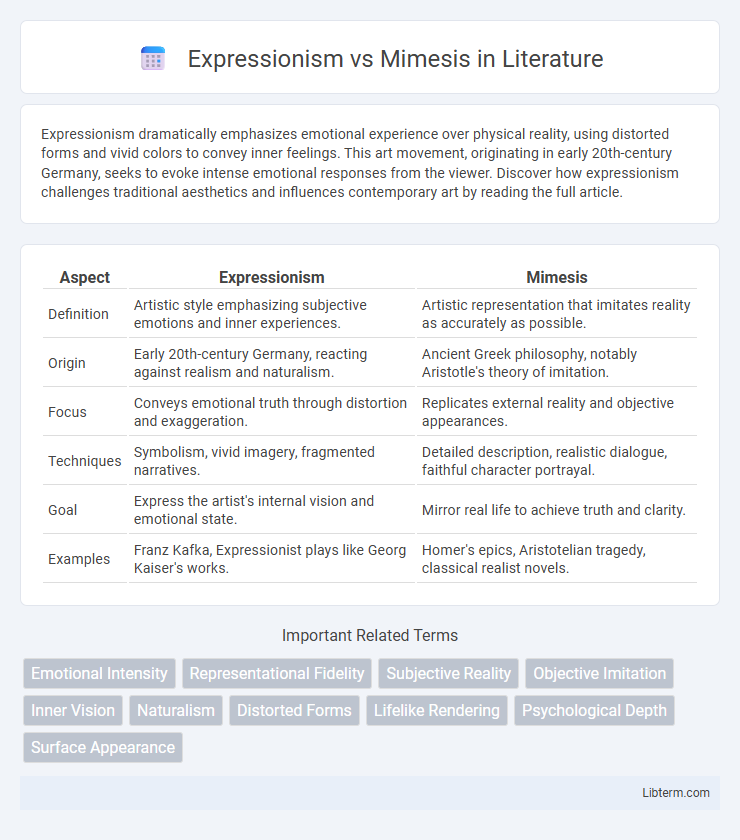Expressionism dramatically emphasizes emotional experience over physical reality, using distorted forms and vivid colors to convey inner feelings. This art movement, originating in early 20th-century Germany, seeks to evoke intense emotional responses from the viewer. Discover how expressionism challenges traditional aesthetics and influences contemporary art by reading the full article.
Table of Comparison
| Aspect | Expressionism | Mimesis |
|---|---|---|
| Definition | Artistic style emphasizing subjective emotions and inner experiences. | Artistic representation that imitates reality as accurately as possible. |
| Origin | Early 20th-century Germany, reacting against realism and naturalism. | Ancient Greek philosophy, notably Aristotle's theory of imitation. |
| Focus | Conveys emotional truth through distortion and exaggeration. | Replicates external reality and objective appearances. |
| Techniques | Symbolism, vivid imagery, fragmented narratives. | Detailed description, realistic dialogue, faithful character portrayal. |
| Goal | Express the artist's internal vision and emotional state. | Mirror real life to achieve truth and clarity. |
| Examples | Franz Kafka, Expressionist plays like Georg Kaiser's works. | Homer's epics, Aristotelian tragedy, classical realist novels. |
Introduction to Expressionism and Mimesis
Expressionism emphasizes the internal emotional experience, distorting reality to evoke subjective feelings and moods. Mimesis focuses on realistic representation, aiming to imitate nature and everyday life with accuracy and clarity. These contrasting approaches shape artistic interpretation, where Expressionism prioritizes emotional truth and Mimesis values objective depiction.
Historical Origins of Both Movements
Expressionism emerged in early 20th-century Germany as an avant-garde movement reacting against the constraints of realism and seeking to portray emotional experience rather than physical reality. Mimesis, rooted in ancient Greek philosophy, particularly Aristotle's Poetics, emphasizes imitation of nature and reality as the foundation of art and literature. The historical divergence highlights Expressionism's focus on subjective perception, contrasting with Mimesis's commitment to objective representation.
Key Philosophical Foundations
Expressionism emphasizes the subjective experience and emotional response, rooted in the philosophy of existentialism and individual perception. Mimesis is grounded in classical realism and Aristotelian philosophy, aiming to represent reality objectively and faithfully. The key distinction lies in expressionism's focus on internal truth versus mimesis's commitment to external reality.
Major Artists and Influential Works
Expressionism, exemplified by artists like Edvard Munch with his iconic "The Scream" and Egon Schiele's raw portraits, emphasizes emotional experience and subjective interpretation. In contrast, Mimesis is represented by artists such as Johannes Vermeer and Diego Velazquez, whose works like "Girl with a Pearl Earring" and "Las Meninas" focus on realistic depiction and faithful representation of life. The divergence between these movements highlights the tension between emotional distortion in Expressionism and accurate imitation in Mimesis, shaping the trajectory of modern art.
Techniques and Stylistic Differences
Expressionism employs distorted forms, bold colors, and exaggerated brushstrokes to convey emotional intensity and subjective experience, often prioritizing inner feelings over realistic representation. Mimesis emphasizes accurate, detailed depictions and lifelike perspectives to imitate reality closely, fostering objective observation and naturalism in art and literature. These stylistic differences highlight how Expressionism abstracts and distorts reality for emotional impact, whereas Mimesis strives for faithful replication and clarity.
The Role of Emotion vs Representation
Expressionism prioritizes the portrayal of intense emotions and subjective experience, often distorting reality to evoke psychological depth and personal truth. In contrast, mimesis emphasizes accurate representation and imitation of the external world, aiming for lifelike detail and objective reality. The role of emotion in expressionism is central, serving as the primary conduit for meaning, whereas in mimesis, emotion is a secondary effect emerging from faithful depiction.
Cultural and Social Impacts
Expressionism emphasizes subjective experience and emotional distortion, profoundly influencing cultural movements that challenge traditional norms and promote individualism in art and literature. Mimesis, rooted in imitation and realism, reinforces social cohesion by reflecting societal values and shared realities, often serving as a tool for cultural preservation and education. The tension between these approaches shapes debates on art's role in society, balancing innovation with tradition and impacting cultural identity and collective memory.
Critical Reception Over Time
Expressionism initially faced criticism for its distorted forms and emotional intensity, seen as a rebellion against realistic representation, while mimesis was praised for its faithful depiction of reality. Over time, Expressionism gained recognition for its psychological depth and innovation, influencing modern art and literature despite ongoing debates. Mimesis remains valued for its clarity and fidelity, but contemporary critics often highlight Expressionism's ability to convey subjective experience as equally important.
Expressionism and Mimesis in Contemporary Art
Expressionism in contemporary art emphasizes the artist's subjective experience and emotional response, often distorting reality to evoke an intense psychological effect. Mimesis, rooted in classical tradition, prioritizes accurate representation and imitation of the external world, aiming for faithful depiction and objective reality. Contemporary art frequently explores the tension between these approaches, blending expressive abstraction with mimetic precision to challenge viewers' perceptions and expand artistic boundaries.
Conclusion: Lasting Legacies and Ongoing Debates
Expressionism revolutionized art and literature by prioritizing emotional experience and subjective interpretation, leaving a lasting legacy in modernist and contemporary creative movements. Mimesis maintained its influence through its emphasis on realistic representation and fidelity to nature, grounding artistic practices in observation and imitation. The ongoing debate between Expressionism and Mimesis reflects enduring tensions between emotional authenticity and mimetic accuracy, shaping diverse aesthetic philosophies and methodological approaches in the arts.
Expressionism Infographic

 libterm.com
libterm.com